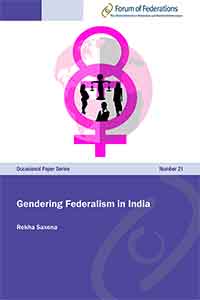Library

Language:
EnglishTopic:
Gender EqualityCollection:
Occasional Paper SeriesCountries:
IndiaAuthors:
This paper seeks to explore the gendered impact of Indian federal structure. Different aspects of federalism such as intergovernmental relations, asymmetrical relations, and multi-level federalism and its impact on the way women’s movement engage with the state structure are discussed. The impact of three-tier federal structure is visible in the presence of women’s organizations at all the three levels. The multi-level federal structure can provide opportunities to women’s organizations for forum-shopping. It can also provide opportunities for policy-innovation and experimentation. Feminist scholars in India have paid little attention to the impact of federal arrangements on women’s politics. Similarly, the huge literature on federalism has neglected the impact of federalism on women’s politics. The debate on asymmetrical federalism in India has till now ignored the impact of asymmetrical federalism
on women’s politics. Despite the fact that strengthening of inter-governmental relations is necessary for the smooth functioning of cooperative federalism, it may have negative consequences for women’s politics since intergovernmental decision-making generally takes place behind closed doors and thus may not be accessible for women’s organizations. Thus this paper represents an attempt towards gendering the federalism discourse in India. It tries to point out certain tendencies regarding the impact of federalism on women’s politics. It seeks to explore the ways through women’s movement negotiate and mediate the mesh of multi-layered federal structure.

